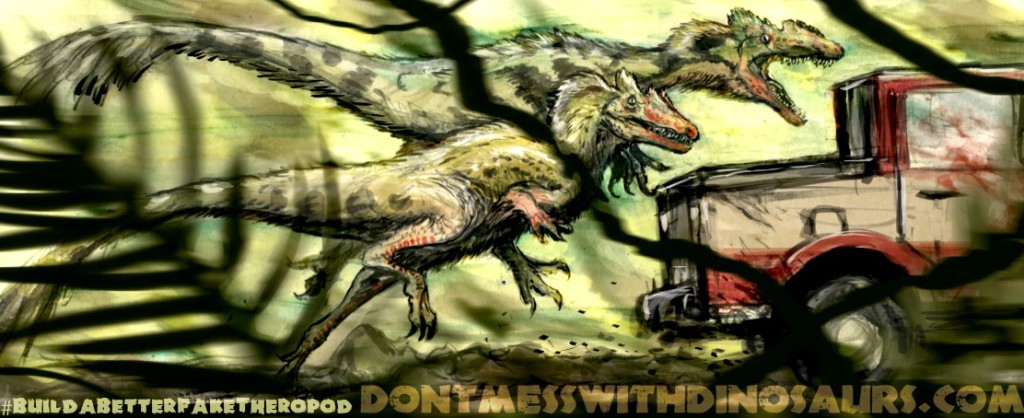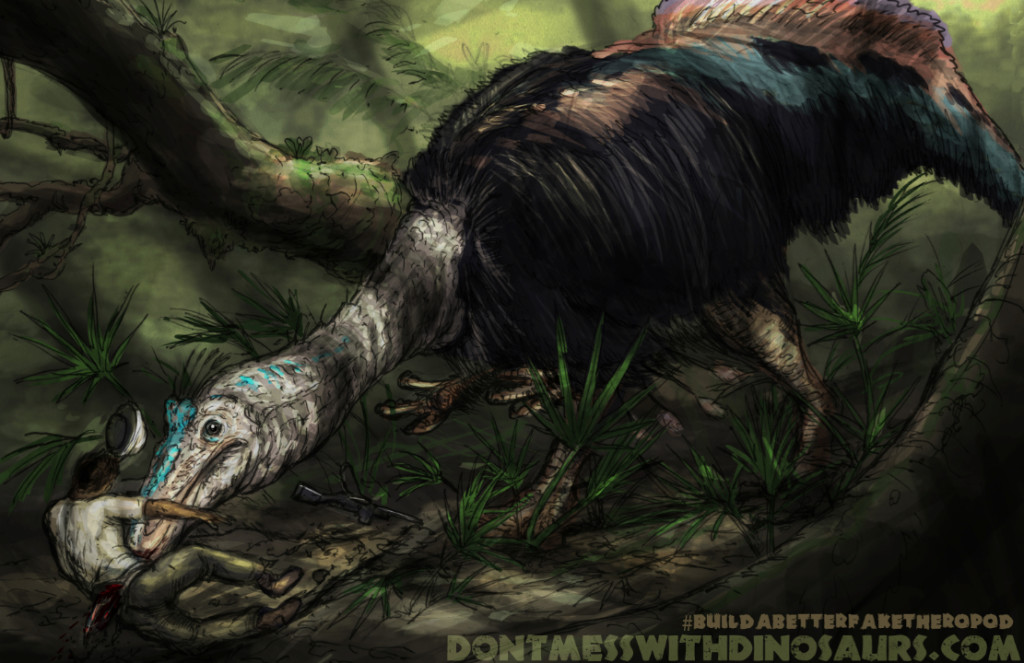#BuildaBetterFakeTheropod …WITH SCIENCE!
If you’ve been following me on twitter you’ll no doubt have found your feed infested with bizarre fictitious dinosaurs with the hashtag #BuildABetterFakeTheropod. The idea behind the hashtag was to try and come up with better, more scientifically inspired fake dinosaur designs than Jurassic World’s dated, unrealistic looking gray behemoth “Indominus rex.” Turns out, coming up with something more interesting and more science based isn’t very hard, because paleontologists have already done a ton of hard work over the last 20 years discovering and describing and educating the public about a diverse menagerie strange and wonderful lifeforms all of which suggests a world of speculative biology ripe for movie-monster exploitation. Over the course of the last few weeks I’ve posted a bunch of illustrations to my twitter and I thought I ought to explain some of the science that inspired a few of them in more than 140 characters.
“Cryptonychus arborealis” a semi arboreal Dromeosaur (“raptor”) from a tropical rain forest environment:

It’s apparently pretty hard to become a fossil. While some environments lend themselves to making fossils more than others, many environments aren’t so good at it, and some are really really bad at it. Tropical rainforests are one of those environments that can be really really bad at making fossils. Constant heat and humidity encourage an abundance of decomposers, and a thick mass of vegetation binds up all the available soil, so things rarely get buried in the mineral rich mud, sand or clay that help preserve remains. What that means is that there are vast swathes of some of the most bio-diverse ancient ecologies that we will never know anything about… That means LOTS of dinosaurs that just rotted and were forgotten. Forever. Now that doesn’t mean we can’t speculate about what might’ve been living in such environments, as many things from environments that were good at making fossils likely had relatives in environments that were not so good at making fossils (as many living things do today).
So, think of humans, or cheetahs. Both are widespread predators (well, cheetahs used to be widespread – once ranging throughout southern Europe, India & the Middle East) who evolved to hunt by chasing things down in an open Savannah environment. But both humans and cheetahs aren’t the only hunting primates or big cats around. We live at the same time as animals that share a common ancestor with us. In the tropical jungles of Africa there are both leopards and chimpanzees, both of which hunt in trees. Now, when I consider that the Velociraptor and Utahraptor that we know about hunted in open floodplains & semiarid woodland environments (good at makin fossils), and they share ancestry with smaller “raptor” dinos that appear to be arboreal (tree climbing) forms (some of which were likely gliders or fliers), I gotta wonder: were their weird big jungle raptors that hunted in way up trees?? My “Cryptonychus” (meaning “hidden claw”) is an attempt to come up with something like that. As it’s name (and hopefully the art) implies, it is a large ambush hunter, with a shaggy coat of feathers to camouflage it amongst the mossy vines an branches as it creeps slowly through the trees until if finds a perch near a game trail or nest. Then it waits… Silent. Motionless. Until the prey comes just… close… enough!
Ornithomimids are the group of Dinosaurs that looked sorta like ostriches but weren’t. The group includes Gallimimus, which was included (albeit featherless) in the first Jurassic Park movie and (even less accurately) in the new movie. Deinocheirus was a weird giant member of this group, and the recent discovery of more of its skeleton shows us that the ornithomimids could get BIG (like around T-rex big) and weird (it had a goddamn hump or sail or something)!
One of the features that made it weird was that, unlike the rest of the (known) ornithomimids, Deinocheirus has a peculiar spoon shaped bill, likely for cropping plant matter or sifting nutritious crud out of the water like ducks do. The rest of the group has more pointed beaks, similar to that of modern generalist feeders like chickens and ostriches and the like. So, if this lineage of dinosaurs evolved a range of bills from sorta-pointy, to really-spoony, why not extra-pointy? It is not uncommon in evolutionary history to see groups of generalist feeders give rise to species or whole groups more specialized for feeding a certain way, which seems to be what Deinocheirus was doing. Perhaps somewhere, lurking in the depths of time, still waiting to be discovered or missed by fossilization completely, there were Ornithomimids adapted to spear and gulp down smaller animals as modern herons do… Oh, and by the way, herons are pretty closely related to spoonbills (they’re both Pelicaniformes).
Early Jurassic “Sinosaur-Line” Theropods

There is a big hole in the fossil record between the smaller late Triassic ceolophysoid theropods and the big giants (Like Allosaurus and Ceratosaurus) that appear in the fossil record in the middle Jurassic. The medium to large sized early Jurassic theropods that have been found (such as Dilophosaurus and Sinosaurus) are rare and many are highly fragmentary, yet they seem to indicate some interesting things were going on. Many of them have strange crests on their heads, and their overall body plan appears to be transitioning from a long and low body plan, to one with more robust legs, arms, heads and necks, likely for taking down larger prey. The creatures in the above drawing are my attempt to visualize a powerful-yet-speedy intermediate form, with ample strength to dispatch human-sized prey, but long powerful legs to chase down even off road vehicles. I, for one, would love to see a chase scene where a pair (or more!) of hungry theropods easily keep pace with a speeding off-road vehicle and the human prey within has to avoid being pulled from a broken window or opened top as the vehicle bounces and lurches in its struggle to navigate the rugged terrain, effortlessly handled by the ancient hunters.
If you like this kind of speculative monster design stuff let me know, & I hope you’ll share it aroundI. If people like it I’ll do another post on a few of my other #buildabetterfaketheropod designs.



Mike Taylor on 15 Jun 2015 at 9:57 am #
Yeah, I’d be interested to see more of these — or, rather, more explanations of some of the other ones you’ve already done.
Historian on 15 Jun 2015 at 11:44 pm #
Thanks Mike! As soon as I have time I’ll write up a little something on my blood-feeding scansoriopterygids and giant marine diving-bird style spinosaurid… And I might have a few others clunkin around in my brain I might be able to shake out.
Taranaich on 20 Jun 2015 at 5:21 pm #
I’m of the opinion the uninspired, dated look of the Murdersaurus was intentionally evocative of the generic giant theropod that’s blighted dinosaur pop culture since the dawn of the medium – exactly the sort of bland committee-driven conclusion you’d get if you worked with focus groups and consultations. It’s one of the many bad decisions taken by the people within the film’s story which led to the outbreak: lack of imagination & arrogance.
That said, I still hate the Murdersaurus, and wholly endorse #BuildaBetterFakeTheropod.
Trey Swenton on 25 Jun 2015 at 4:40 am #
Cool Concept! Could you check out my fake theropod? http://agentlemanscientist.deviantart.com/art/My-Build-a-Better-Fake-Theropod-541926713
Vasika Udurawane on 06 Jul 2015 at 1:35 am #
Hi. I’ve been writing for moviepilot.com for a while and is it alright if I mention #buildabetterfaketheropod in one of articles next month? I’d love to give it some more publicity.
peter on 17 Jul 2015 at 8:58 pm #
I love dinosaurs so much
Francois on 26 Sep 2020 at 10:32 am #
You would make a really good Jurassic park movie or at least make great (pretty accurate too) dinosaur designs for a Jurassic Park movie. I hope one day we will real dinosaur horror movies with dinosaurs looking like that, like your drawings. These days film makers are forced to make dinosaur movies less scary/horror because of a countless number of children being attracted by these extinct animals and by the name. Jurassic Park (1993) could have been a true horror movie with scarier, gruesome, creepy and gory scenes. But I think director Steven Spielberg thought of he had the second thought of what about all the children who will be hype to se this dinosaur movie and parents telling them they can’t see it because it’s a movie for grownups. I hope and pray for such a movie to be filmed one day. When that happens, I hope they hire you sir Brian Engh to design the dinosaurs. Definitely don’t mess with dinosaurs.